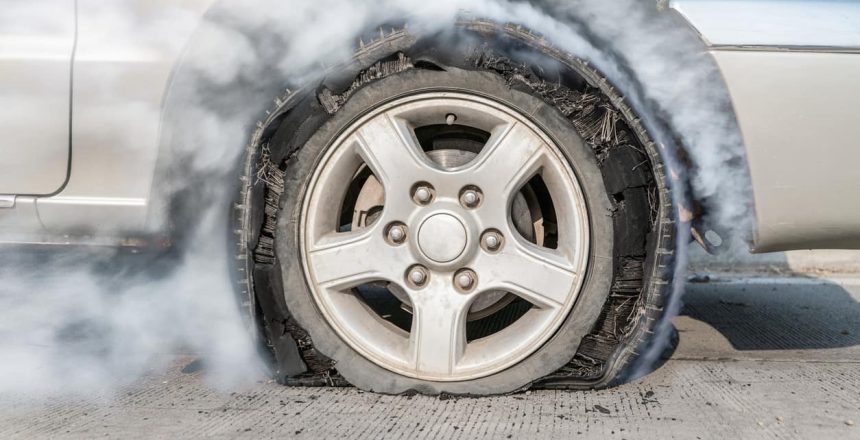A flat tire should be a red flag to immediately get off the road to protect yourself, your vehicle, and other people.
Key Takeaways:
- Hundreds of deaths and tens of thousands of accidents occur because of tires.
- Distance to your destination makes no difference to flat tire dangers.
- Risks include punctures, cracks, tread loss, and low pressure.
- Proactive testing can keep drivers safe and prevent tire trouble.
- Working with an experienced auto transport broker can get your car safely over long distances without any tire-related hazards.
Never driving on a flat tire is in the top tier of safe road habits. Also, never drive drowsy and always wear your seatbelt. All three are overlooked way too often for the same reason: How much harm can it do if the destination is close?
It can be tempting to drive with a flat using that reasoning. It can also be dangerous or even deadly. Driving with a flat can seriously damage the rims or other parts of the vehicle. Most importantly, it could cause you to lose control of the car. Making sure you change the tire or get towed the moment you notice is the right thing to do. Here’s why.
The Many Causes of Flat Tires
Punctures, insufficient air pressure, and surface cracks can all-cause (or at least greatly increase the chances of) a flat. Tire age is also a big factor in how close you are to getting a flat. Wear and tear diminish tire treads over time. Also, a serviceably performing tire that’s near the end of its recommended lifespan is a liability. Therefore, replace it before it has a chance to cause trouble.
You may also see swelling or buckling of the tire’s sidewall, which can be an inherent defect in the tire or caused by driving on a compromised one. Wheels can corrode and lead to air leaks around the edge of the wheel. Any of these is cause for immediate repair or replacement before the following risks start affecting you.
How Tire Dangers Develop and Become Dangerous
Driving even a mile on a flat tire is a terrible decision. Tire issues cause around 33,000 accidents every year, resulting in over 200 deaths and 11,000 crashes. Accepting these statistics puts drivers in a proactive mindset that could save them a fortune in repairs or even their lives.
Driving on a tire that’s not properly inflated causes an excess buildup of heat that speeds tire damage. This is because low inflation puts more of the tire’s rubber in contact with the road than is necessary, creating the kind of friction that can further deflate or even pop a tire entirely. Poor inflation also causes vehicle-wide stress that compromises driver control, including added pressure on brake lines.
Tires that deteriorate enough can start to disintegrate. Imagine having a bunch of small whips rapidly rotating in your wheel. You’ll get some idea of the damage that can be caused. Thinning tires can also expose your wheel rims to the road and bend them out of shape. Bent rims damage tire walls and compromise tire pressure because the sealed area between wheel and tire is no longer strong.
Other telling signs of failing tires are increased stopping distance, increased gas consumption, and the classic giveaway of audible tire flaps. There are some tried-and-tested methods that cost very little money to implement compared to the huge repair bills and medical costs they could help prevent.
How to Avoid Flat Tire Dangers
Measuring tire pressure is easier than ever today, thanks to post-2007 vehicles having Tire Pressure Monitoring systems onboard. You can alternatively use a tire pressure gauge at regular intervals to monitor air retention and proper inflation.
The recommended pressure for your vehicle will be in the owner’s manual and often on a sticker inside the driver’s door. Cold weather can lower tire pressure, while hot weather can increase it. Once a month or during any temperature shifts are good times to check. Remember that overinflated tires are a risk, just like underinflated ones.
It’s generally accepted that a tire with a tread shallower than 2/32nds of depth puts drivers at risk. You can measure that cheaply using the penny or quarter test or checking the tread wear bar indicator.
When You Have to Change a Tire
Sometimes a flat tire is unavoidable due to punctures that happen too quickly to prevent. If you’re on the road when it happens, you must get the car to a safe position away from oncoming traffic and turn on both the handbrake and your hazard lights. You’ll need your vehicle owner’s manual, a flashlight, carjack, and lug wrench, along with a fully inflated spare before you start changing the tire.
Other helpful items are a sturdy pair of work gloves, wheel wedges to prevent rolling while you swap tires, and something to secure the jack in place. Jacks can be tricky, so make sure you’re confident in how to use one. Alternatively, you can call a reliable towing service that may be able to change your tire or take you and your vehicle to someone who can.
You may not even need a tire change right away since some punctures can be shored up with a tire plug. This is only a temporary solution at best, though. A mechanic should be consulted as soon as possible on whether the best solution is a more extensive repair or total tire replacement.
FAQs on The Dangers of a Flat Tire
Can a flat tire damage other parts of the vehicle?
Yes, driving on a flat tire can cause damage to the rim and other parts of the suspension system.
What is the risk of driving on an underinflated tire?
Driving on an underinflated tire can increase the risk of a blowout, reduce fuel efficiency, and cause uneven wear on the tire.
Can a flat tire cause a fire?
In rare cases, a flat tire can cause a fire if it rubs against the vehicle and generates enough heat to ignite flammable materials.
Stay Safer on The Road with Mercury Auto Transport
Our team is here to put drivers in touch with reputable auto carriers all over America. When you’ve got a long road journey ahead of you, the odds of tire issues and many other risks are increased.
Handing the keys to an auto carrier removes those dangers. It also keeps you, your vehicle, and other people on the road safe. Contact our auto transport specialists at info@mercuryautotransport.com or call 800-553-1828 to find out more.






